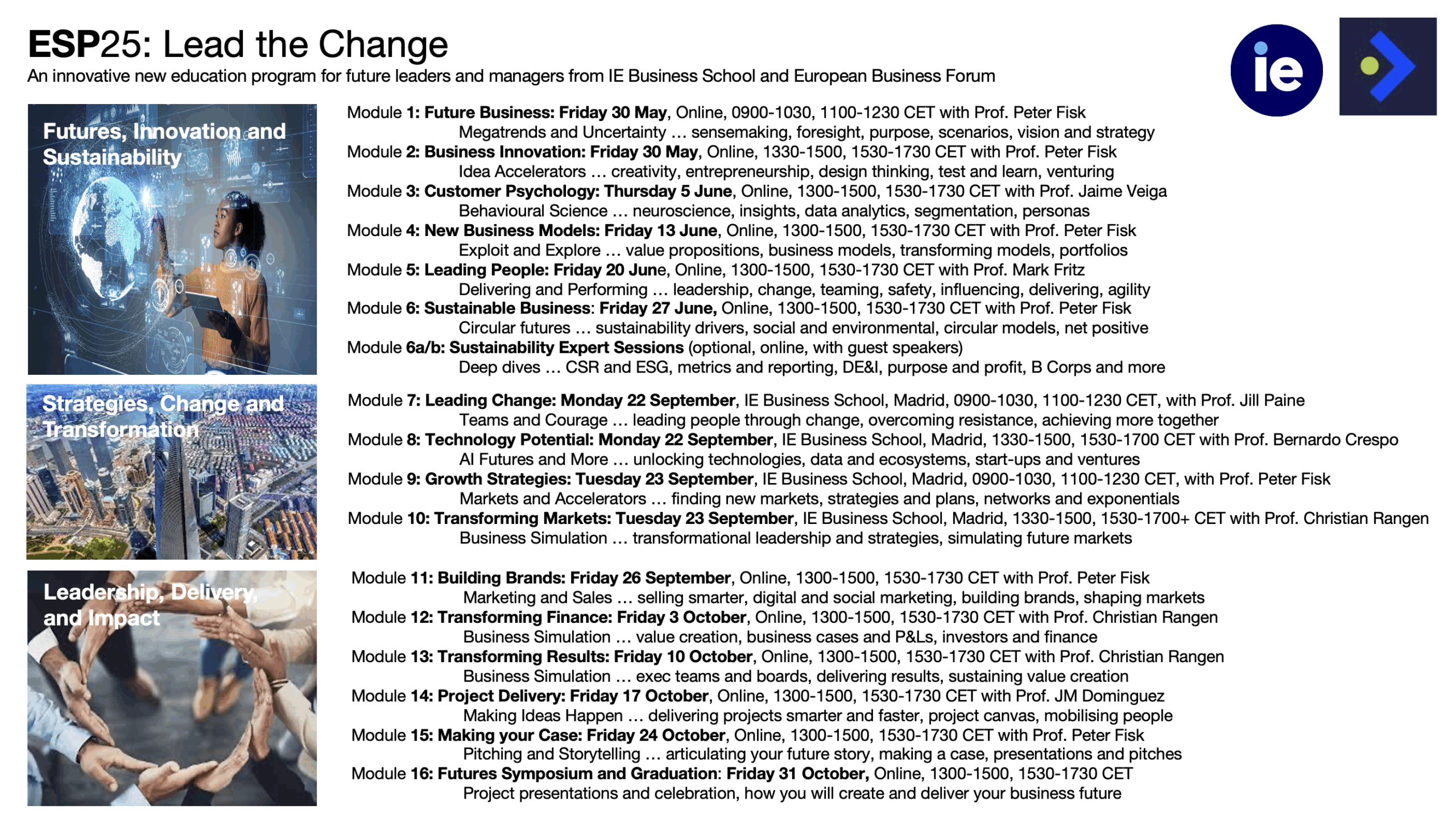Lead the Change: Building Brands
September 26, 2025 at ESP25

Incredible technologies and geopolitical shifts, complex markets and stagnating growth, demanding customers and disruptive entrepreneurs, environmental crisis and social distrust, unexpected shocks and uncertain futures.
For every business leader, the challenge is about making sense of today’s rapidly changing world, and understanding how to prepare for, and succeed, in tomorrow’s world.
We explore how businesses can survive and thrive, and move forwards to create a better future. How to reimagine business, to reinvent markets, to reengage people. We consider what it means to combine profit with more purpose, intelligent technologies with creative people, radical innovation with sustainable impact.
We learn from the innovative strategies of incredible companies – Alibaba and ASML, Biontech and BlackRock, Canva and Collossal, NotCo and Netflix, Patagonia and PingAn, Spotify and Supercell, and many more. We also take a look at what this means for insurance, and some of the most innovative companies in the field.

Are you ready to seize the opportunities of a changing world?
How will you – and your strategy, organisation, people and projects – embrace the challenges and opportunities of change ahead of us? Where are your biggest opportunities for innovation and growth? What are your priorities to balance short and longer term? How will you behave as a manager and leader?
We’ve developed a new program for business leaders, managers of companies large and small, to get up to speed with the very latest ideas, tools and approaches to business, learning from companies and experts around the world. It’s called the Executive Management Program, delivered as a hybrid program online and in face to face in Madrid.
It’s like a Mini MBA, but fit for today’s world, where challenges like economic uncertainty and climate change are matched by opportunities like the applications of AI and new business models. It includes an exciting dynamic business simulation, about managing and leading change, plus insights and ideas from the world’s most interesting companies, right now.
In fact it brings together much of the Global Online MBA from IE Business School, which is ranked #1 in the world, and in particularly for topics such as ESG and sustainability. The faculty is made up of expert professors from IE and beyond, and we spend a number of days in Madrid at IE’s Executive Education campus.
For more info, contact me directly: peterfisk@peterfisk.com

Module 11: Building Brands
In today’s dynamic, hyperconnected world, building a brand is not just about designing a great logo or running catchy ads. It’s about creating a compelling identity that resonates with people, stands out in saturated markets, builds deep trust, and fuels your company’s ongoing innovation and growth. The brand has become a business’s most powerful intangible asset—a strategic tool that shapes perceptions, drives loyalty, attracts talent, and helps companies adapt to change. In a landscape defined by constant disruption, relevance, and differentiation are no longer optional—they are existential.
The pace of change in the business environment has accelerated. Consumer expectations are rising, markets are fragmenting, competitors are multiplying, and technology is reshaping how people interact with products and companies. In this environment, brands must do more than communicate—they must connect. Successful brands today are dynamic, participatory, and purpose-driven. They reflect cultural relevance and societal values, they evolve with their customers, and they embody trust at a time when skepticism toward institutions and corporations is widespread.
Moreover, branding is no longer just a marketing function. It is a whole-business strategy. Every product choice, policy, partnership, and employee interaction communicates something about your brand. It is how the world sees you—and how you see yourself.
Creating a powerful brand identity
At the heart of every great brand is a powerful identity. This goes beyond visual aesthetics—it’s about defining who you are, what you stand for, and what makes you different. A strong brand identity starts with clarity:
-
Purpose: Why does your brand exist beyond making money? Brands with a clear, authentic purpose—like Patagonia’s environmental activism or Airbnb’s sense of belonging—win hearts and build meaning.
-
Positioning: What space does your brand occupy in the minds of customers? Effective positioning highlights your unique value and frames your relevance in a way that’s compelling and memorable.
-
Personality: Brands, like people, have personalities. Whether you’re bold, quirky, authoritative, or compassionate, consistency in tone, voice, and behavior makes your brand more relatable and human.
-
Promise: What do customers count on you to deliver? Your brand promise sets expectations—and your ability to keep it builds trust.
Crafting these foundational elements requires deep insight into your customers, competitors, and culture. It’s not about inventing something out of thin air—it’s about discovering and amplifying the truth of who you are and what matters most.
The best brands do more
New brand-building strategies are not about louder messages—they’re about deeper meaning, mutual value, and authentic relationships. The most powerful modern brands plug into culture and purpose, empower people and communities, are co-created and emotionally intelligent, evolve like living organisms, and build long-term ecosystems and trust
In the era of infinite choice and fleeting attention, the brands that win are those that matter—because they stand for something real, and invite people to be part of it. Here are 10 ways in which they do more
- Brands as Cultural Connectors: In today’s fragmented, globalized world, brands that resonate culturally are the ones that endure. Cultural connection goes beyond superficial trends—it means aligning with deeper societal values, subcultures, and moments of collective meaning. Nike connects with issues of racial justice and athlete activism. Rihanna’s Fenty brand taps into identity, representation, and body positivity. These brands act as mirrors to culture—and sometimes even shape it. They understand the power of symbolism, language, and representation to create relevance. Brands are becoming cultural vehicles—platforms through which people express their beliefs and participate in social movements.
- Brands as Enablers of Human Potential: More than ever, consumers expect brands to empower them—not just sell to them. This means helping people learn, grow, express themselves, or make an impact. Apple frames itself not just as a tech company but a tool for creativity. Nike encourages people to “just do it” and pursue personal greatness. Notion and Figma empower users to design and build with autonomy. This shift reflects a more human-centric view of branding. People don’t want brands to dominate—they want them to serve. Brands as enablers of self-actualization—tools that help people unlock their best selves.
- Tribal Branding: Becoming a Symbol of Belonging: Some of today’s most successful brands function like tribes—they foster identity, belonging, and shared rituals. These are brands people don’t just buy, but join. Harley-Davidson, Supreme, Liquid Death, and Peloton have become cultural tribes. Communities around brands like Patagonia or Glossier are self-reinforcing, with strong peer-to-peer advocacy. Tribal brands provide people with a sense of belonging in a world where traditional communities are breaking down. They often thrive on exclusivity, symbolism, and strong emotional ties. Brands as identity platforms—ways for people to say, “This is who I am.”
- Participatory Brands: Co-Created with the Community: The top-down era of brand control is fading. The most innovative brands today are participatory and co-created. Customers aren’t just consumers—they’re contributors, collaborators, even co-owners. LEGO Ideas lets fans submit and vote on new set designs. Red Bull supports creator-athletes who shape the brand narrative. DAO-based brands (e.g. in Web3) enable decentralized ownership and governance. These brands create space for people to shape their evolution, fostering deep loyalty. Brands are becoming community-driven ecosystems—living, evolving entities shaped by their users.
- Brands with Regenerative Purpose: Sustainability is no longer a differentiator—it’s a baseline expectation. But the most forward-looking brands go beyond “do less harm” toward regeneration—actively restoring the environment, society, and economy. Patagonia reinvests profits in environmental causes. Interface aims to become a “climate positive” carpet company. Allbirds, On Running, and others are innovating around circular materials. Regenerative brands integrate purpose not as a side project, but as a core innovation driver. This deep commitment strengthens credibility and long-term loyalty. Brands as becoming healing forces—agents of restoration, not just responsibility.
- Emotionally Intelligent Branding: As technology grows more automated, emotionally resonant brands are standing out. Emotionally intelligent brands understand human needs, moods, and psychology—and communicate with nuance, empathy, and warmth. Duolingo’s playful tone makes learning fun. Oatly’s irreverence creates emotional dissonance and memorability. Spotify Wrapped taps into personal nostalgia and celebration. These brands master tone, timing, and context in ways that feel human, not corporate. Brands are becoming emotionally intelligent companions—understanding and engaging people like a trusted friend.
- Modular and Fluid Brand Identities: Static logos and rigid visual systems are being replaced by fluid, adaptive brand identities. These identities shift across platforms, products, and contexts—while remaining instantly recognizable. Spotify, Google, and Netflix all use dynamic branding systems. Modular design allows brands to localize, personalize, and evolve without losing coherence. In a world of real-time interaction and user-generated content, flexible brand systems allow for creative freedom without fragmentation. Brands are becoming living systems—designed for movement, iteration, and responsiveness.
- Brands with Narrative Depth: Storytelling has long been central to branding, but today’s leading brands are building narrative worlds—deep mythologies and multi-layered stories that people can explore and extend. Disney has built an entire multiverse of characters and experiences. Nike builds narratives around athletes and challenges, creating arcs of personal triumph. Liquid Death turns water into a rock-and-roll mythology. Great brand storytelling today is immersive, serialized, and layered. It invites participation, spurs emotion, and earns attention in an overstimulated world. Brands are becoming narrative universes—places to lose and find yourself.
- Brands as Interfaces to Ecosystems: Many of today’s top companies are platforms or ecosystems—not just products. Their brands are interfaces to larger value networks. Amazon is the gateway to retail, logistics, cloud, and media ecosystems. Apple is the interface to a universe of apps, services, devices, and creators. Airbnb connects hosts, travelers, experiences, and local economies. This model means branding must unify disparate experiences into a coherent whole. The brand becomes the trust layer between complexity and usability. Brands are becoming ecosystem gateways—seamless entry points into a network of value.
- AI-Enhanced Personal Brands: Finally, AI is enabling ultra-personalized brand experiences—from marketing to customer service to product design. Spotify, Netflix, and TikTok tailor content with algorithmic precision. AI-driven chatbots and assistants are becoming the voice of the brand. Brands like Replika and Character.AI are exploring virtual brand personalities as companions or co-creators. The future of branding may be one-to-one rather than one-to-many, where each person experiences the brand in a uniquely tailored way. Brands are becoming intelligent companions—responsive, adaptive, and personalized in real time.
Branding as a business driver
In today’s world, branding is not a surface exercise—it is a business imperative. It is the connective tissue between strategy and execution, between vision and value, between innovation and emotion. A strong brand amplifies your voice, fuels your growth, and anchors you in a sea of change.
To build a great brand today:
-
Start with purpose and truth.
-
Be bold, relevant, and distinctive.
-
Prioritize trust and long-term reputation.
-
Align culture and operations with your brand.
-
Use your brand as a springboard for innovation and expansion.
In a world where products can be copied and technologies become obsolete, your brand is what endures. It is your story, your promise, and your relationship with the world. Invest in it wisely—it will be your greatest asset in a fast-changing future.
Find out more and book >